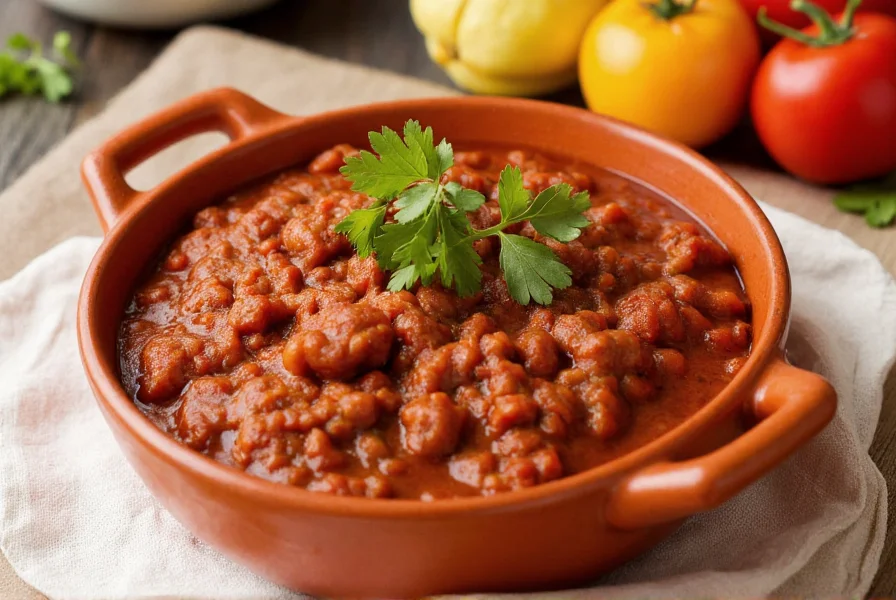The best chili recipe combines quality ingredients, proper spice balance, and sufficient simmer time. A classic chili features ground beef or chuck roast, kidney beans or pinto beans, tomatoes, onions, garlic, and a carefully balanced blend of chili powder, cumin, and paprika. The secret to exceptional chili lies in the "holy trinity" of cooking techniques: browning meat properly, layering spices, and allowing at least 90 minutes of simmering time for flavors to meld. This authentic approach creates a rich, complex flavor profile far superior to quick-prep versions.
Chili stands as one of America's most beloved comfort foods, with regional variations spanning from Texas-style meat-only recipes to Cincinnati's distinctive cinnamon-kissed versions. While many consider chili a simple weeknight meal, crafting truly exceptional chili requires understanding the culinary science behind each ingredient and technique. This guide provides not just a recipe, but the foundational knowledge that transforms ordinary chili into something extraordinary.
The Essential Components of Authentic Chili
Creating memorable chili begins with understanding its fundamental elements. Unlike many online recipes that treat chili as mere assembly of ingredients, professional chefs recognize that each component serves a specific purpose in building flavor complexity.
Meat Selection and Preparation
The protein foundation makes or breaks your chili. For traditional chili, use 80% lean ground beef or, better yet, cubed chuck roast for superior texture and flavor. The fat content is crucial—too lean and your chili lacks richness; too fatty and it becomes greasy. When browning meat, resist the urge to stir constantly. Allow proper searing to develop fond (those browned bits at the bottom of the pot), which contains concentrated flavor compounds essential for depth.

Bean Strategy: To Include or Not?
This remains chili's most contentious debate. Traditional Texas chili connoisseurs reject beans entirely, while Midwestern and Eastern recipes often feature them prominently. For home cooks, the decision depends on your desired texture:
| Bean Type | Texture Contribution | Best For |
|---|---|---|
| Kidney Beans | Firm, holds shape | Hearty, traditional chili |
| Pinto Beans | Creamy when cooked | Thick, rustic chili |
| Black Beans | Firm with earthy flavor | Southwest-style chili |
| No Beans | Pure meat focus | Texas-style chili |
Perfect Homemade Chili Recipe
This tested recipe delivers restaurant-quality results with accessible ingredients. The method emphasizes flavor development through proper technique rather than relying on excessive spices to mask shortcomings.
Ingredients
- 2 lbs (900g) chuck roast, cut into 1/2-inch cubes
- 1 large yellow onion, finely diced
- 4 cloves garlic, minced
- 3 tbsp chili powder (preferably Ancho)
- 2 tsp ground cumin
- 1 tsp smoked paprika
- 1 (28-oz) can crushed tomatoes
- 1 (15-oz) can kidney beans, drained (optional)
- 1 1/2 cups beef broth
- 2 tbsp masa harina (corn flour)
- Salt and freshly ground black pepper to taste
Equipment
- 6-quart heavy-bottomed pot or Dutch oven
- Wooden spoon
- Measuring spoons and cups
- Sharp chef's knife
Step-by-Step Instructions
- Prepare the meat: Pat chuck roast cubes dry with paper towels. Season generously with salt and pepper. Heat 1 tbsp oil in your pot over medium-high heat until shimmering.
- Sear the meat: Working in batches to avoid crowding, brown meat on all sides (about 3-4 minutes per batch). Transfer to a plate. Do not skip this step—proper browning creates the flavor foundation.
- Sauté aromatics: Reduce heat to medium. Add onions and cook until translucent (5-7 minutes). Add garlic and cook 1 minute until fragrant.
- Bloom spices: Stir in chili powder, cumin, and smoked paprika. Cook 1 minute until fragrant—this activates flavor compounds.
- Combine ingredients: Return meat to pot. Add crushed tomatoes, beef broth, and drained beans (if using). Bring to a gentle simmer.
- Simmer: Reduce heat to low. Cover partially and simmer for at least 90 minutes, stirring occasionally. For even better results, simmer 2-3 hours.
- Thicken: In a small bowl, whisk masa harina with 1/4 cup water until smooth. Stir into chili and simmer 10 more minutes until thickened to your preference.
- Season: Taste and adjust salt, pepper, and spices as needed. For acidity balance, add 1 tsp cider vinegar if desired.

Expert Tips for Superior Chili
Professional chefs employ these techniques to elevate their chili beyond basic recipes:
The Secret Ingredient Strategy
While many claim to have "secret" chili ingredients, the most effective additions serve specific culinary purposes:
- Dry sherry (2 tbsp): Adds complexity without noticeable alcohol flavor
- Unsweetened cocoa powder (1 tbsp): Enhances richness and balances acidity
- Strong coffee (1/4 cup): Deepens meat flavors without coffee taste
- Lime zest (1 tsp): Brightens heavy flavors without adding liquid
Avoiding Common Chili Mistakes
Even experienced cooks make these errors that compromise chili quality:
- Adding all spices at once: Different spices require different activation times. Bloom dried spices in oil before adding liquids.
- Insufficient simmer time: True flavor development requires minimum 90 minutes. Rushing creates one-dimensional chili.
- Over-reliance on canned chili powder: Freshly toasted and ground whole spices create superior flavor.
- Adding beans too early: If using beans, add during the last 30 minutes to maintain texture.
Variations for Different Dietary Needs
This adaptable recipe accommodates various preferences while maintaining authentic flavor:
Vegetarian Chili Recipe with Beans
Substitute the beef with:
- 2 cups cooked lentils
- 1 cup diced mushrooms (for umami)
- 1 cup roasted sweet potatoes
- Use vegetable broth instead of beef broth
Slow Cooker Chili Recipe
After browning meat and sautéing aromatics:
- Transfer everything to slow cooker
- Cook on low for 6-8 hours or high for 3-4 hours
- Add masa slurry during last 30 minutes
Serving Your Perfect Chili
Authentic chili deserves thoughtful presentation. Traditional Texas chili is served with:
- Oyster crackers on the side
- Raw white onion for topping
- Lime wedges for brightness
For heartier meals, consider:
- Cornbread (not muffins—traditional skillet cornbread)
- Shredded cheddar or Monterey Jack cheese
- Sour cream or Mexican crema
Frequently Asked Questions
How long should chili simmer for best flavor?
For optimal flavor development, chili should simmer for a minimum of 90 minutes. Professional chefs recommend 2-3 hours for the deepest flavor profile. The extended cooking time allows collagen in the meat to break down into gelatin, creating a richer texture, while spices fully integrate and mellow.
Can I make chili the day before serving?
Yes, making chili a day in advance often improves flavor. Cool it quickly after cooking, store in an airtight container in the refrigerator, and reheat gently the next day. The resting period allows flavors to meld further. Many chili competitions actually require entries to be made at least 24 hours before judging for this reason.
What's the best way to thicken chili?
The most authentic thickening method uses masa harina (corn flour). Mix 2 tablespoons with 1/4 cup cold water to create a slurry, then stir into simmering chili and cook 10 minutes. Alternatively, you can partially mash some beans before adding them, or remove the lid during the last 30 minutes of cooking to allow evaporation. Avoid using flour directly as it can create a pasty texture.
Why does my chili taste bland?
Bland chili typically results from one of three issues: insufficient salt, inadequate spice blooming, or insufficient cooking time. Always season in layers—salt the meat before browning, season the aromatics, and adjust at the end. Properly blooming spices in oil before adding liquids activates their flavor compounds. Finally, chili needs sufficient simmer time for flavors to develop and integrate—rushing the process creates flat-tasting results.
Can I freeze homemade chili?
Yes, chili freezes exceptionally well. Cool completely, then store in airtight containers with 1/2 inch headspace for expansion. Properly stored, it maintains quality for 4-6 months. When reheating, thaw in the refrigerator overnight, then warm gently on the stove, adding a splash of broth if needed. Freezing often improves flavor as ingredients continue to meld during storage.











 浙公网安备
33010002000092号
浙公网安备
33010002000092号 浙B2-20120091-4
浙B2-20120091-4